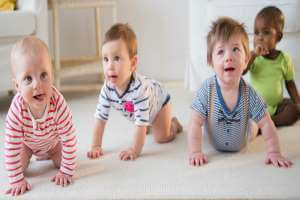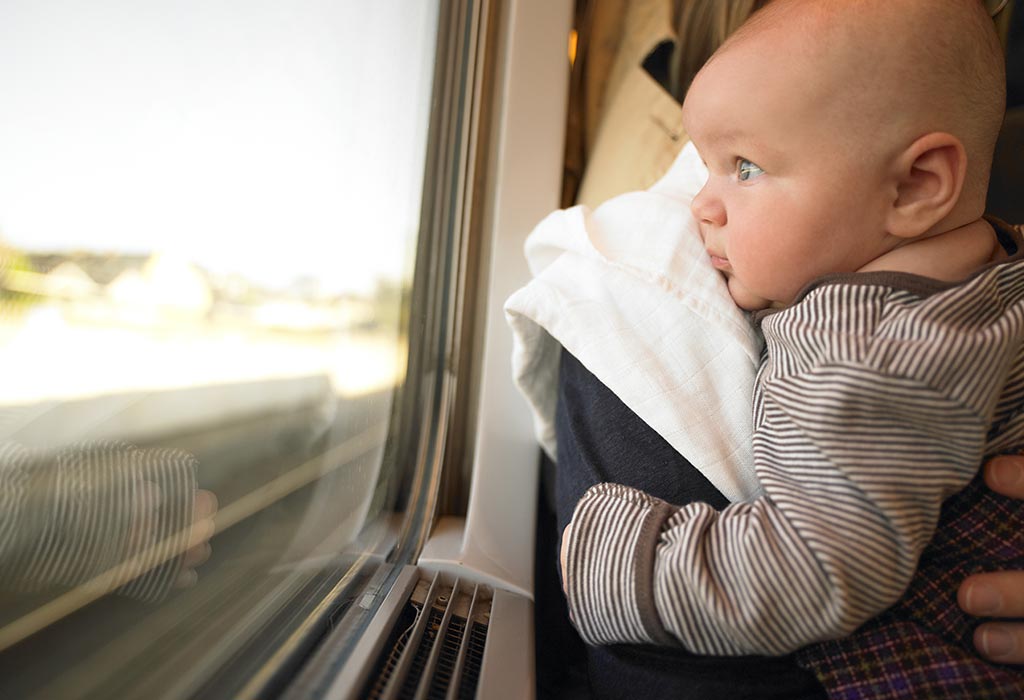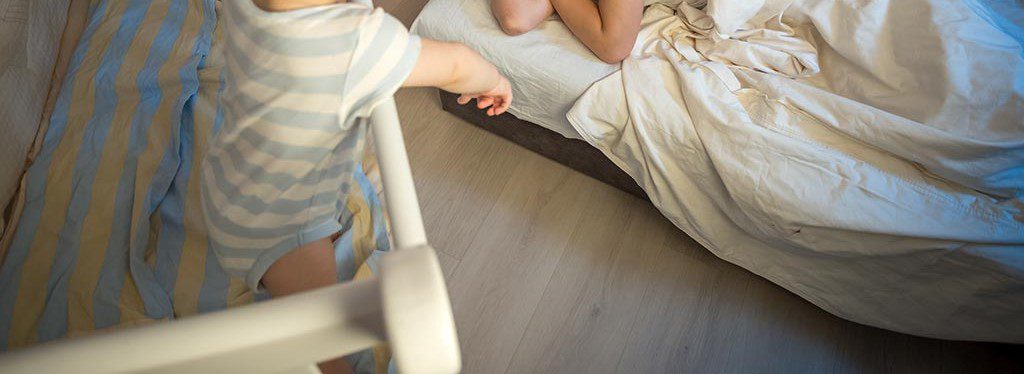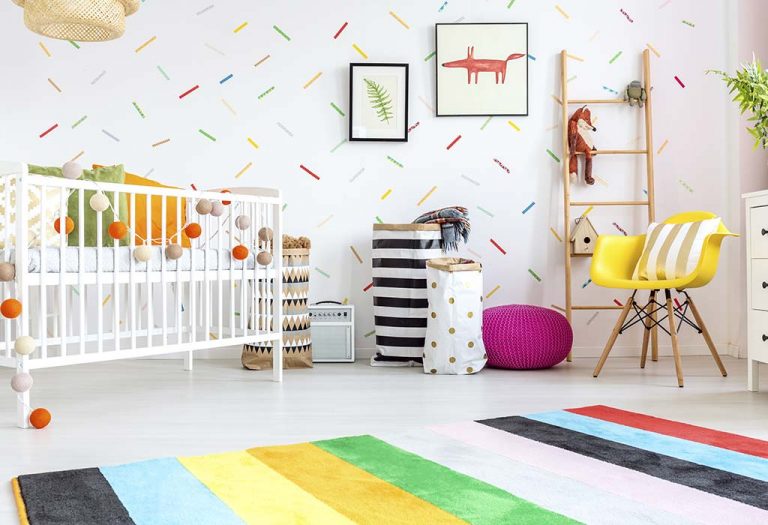Crawling in Babies During the first year, babies learn some basics like holding their heads up and sitting up. Parents often wonder, “When do babies crawl?” Crawling is one of the milestones the whole family looks forward to—it’s so cute.

Since every child is different, this isn't a question with a definitive answer. Many parents worry if their child is behind or skipping a milestone. We'll help ease your thinking by covering everything you need to know about crawling.
At what age do babies crawl?
Babies begin crawling at around 7 to 10 months of age. However, don't worry if your baby isn't crawling by then. During the early crawling stage, your baby may look like a soldier in training.
Premature crawling often consists of a baby dragging their tummy across the floor, using only their arms to build speed. Babies can use different patterns when it comes to crawling, and even twins can use completely different techniques.
Some babies may crawl on their bottoms, but don't worry about their technique—crawling is what's most important. Here are some common crawling techniques:
Classic crawl
Although we call it classic crawling, it's not the most common method. Classic crawling is when your baby crawls on all fours, distributing their weight over their hands and knees. As they move, the opposite arm and leg work together to propel their body forward while maintaining balance. This crawling will teach your baby balance, but don't worry if your baby doesn't use this technique. They can learn using any method.
Do you need: Is it safe to use clove oil to relieve teething pain in children?
crawling on the stomach
This is a typical technique used by babies when they first begin to crawl. They pull their bellies along the surface while using their arms. At this point, their legs dangle behind them, contributing little to the movement.
rolling crawl
Rolling is when a baby rolls to a desired location. It's not crawling per se, but it's a start. Rolling typically occurs after 6 months of age when the core muscles become strong enough to enable rolling from back to tummy. When your baby reaches this milestone, it's important to pay attention to where they roll to prevent injury (i.e., off the bed).
crawl like a bear
As a modification of the classic crawl, a baby using this technique will be on all fours but with their knees and elbows propped up. This movement resembles a bear cub, and while it may not seem effective, you'll be surprised at how quickly a baby can get around this way.
crawl like a crab
Babies who are crawling may seem like they're still figuring out how to move around. They'll use their arms to move backward and sideways. After that, they'll generally use only one leg for speed, keeping one leg tucked under their body while the other is outward.

How do babies learn to crawl?
Crawling is no easy task for a baby who is still developing muscles. It requires both body and mind to accomplish it. Before your baby can crawl, the muscles in their neck, shoulders, back, core, and arms must be strong enough. These muscles must support your baby's weight while maintaining balance so they don't tip over.
While crawling, babies use something called binocular vision, similar to adults, which develops from about 12 to 16 weeks of age.
This type of vision allows a child to switch back and forth between scanning the distance and looking at their hands. Doing so helps them build depth perception while giving their mental muscles a thorough workout.
Do you need: Goodbye to colic in infants and welcome to a comfortable feeding?
Once moving, your child develops their memory skills. You will soon notice that they recognize different routes as they head to places like the couch and around the coffee table for their toys.
As your baby begins to crawl, they'll gradually learn how to get from a sitting position to all fours. It may take some trial and error—a few landings on the floor are normal before mastering it. Most babies get on all fours, then slowly rock back and forth before gaining the confidence to move forward. They use one of the crawling patterns above once they're confident, or a combination, to gain momentum.
Generally, around 9 to 10 months is when babies gain significant speed. By this time, babies will have figured out how to use their legs and arms efficiently. As they gain confidence, your baby will likely attempt to return from all fours to a sitting position, usually around 9 to 10 months. By 12 months, they'll be a fully confident crawler, ready for the next stage: cruising or walking.
Do you need: Why newborns don't cry? Is there a risk to the baby?
How can you help your baby crawl?
tummy time
Tummy time is essential from infancy. By placing your baby on their tummy and playing or interacting with them, they'll develop the muscles needed for crawling. The best opportunity for tummy time is during the hours when your baby is alert and in a relatively good mood. Gently turn your baby over and let them stay there for a few minutes, or until they've had enough.
Always be sure to stay close by to monitor your baby and ensure they are breathing. The best places for tummy time are either on a blanket, a low rug, or a specialized mat. In addition to building muscle, tummy time also helps prevent flattening of the occipital bones on the back of your baby's head.
You may notice a similar flattening on one side of the head if your baby prefers to hold his or her head in one direction. This occurs when your baby spends a lot of time on his or her back while breastfeeding.
Spending less time on your baby's tummy may delay crawling. If your baby uses his arms and legs equally, spending more time on his back won't affect crawling. Always place your baby on his back to sleep.
1.
When your baby was learning to grab objects, you likely used toys to motivate them. This also helps with crawling, perhaps more effectively since your baby can see better. By placing a favorite toy or other desirable object in front of them, you encourage them to move forward. Place it out of your baby's reach, but not too far away—you don't want to frustrate them.
You can also make it fun by creating a small obstacle course once your child becomes more confident. Get some pillows, couch cushions, and boxes to create a fun course for them to navigate. By doing this, you'll help improve your child's speed, agility, and confidence.
You can also invest in other fun things like crawl tunnels and tents, which are a crawler favorite. This is much more engaging than simply getting from point A to point B. However, always stay close by—your baby could get stuck or suffocate under a pillow if left unattended.

standing and sitting
Once your baby can support his head, you can help him progress by standing on him. Place your hands under your baby's arms and lift them so that his feet are on the floor. You support him so that he puts some of his weight on his legs. This serves as a wake-up call for the lower body muscles, which are essential for crawling and walking.
Most infants can place their feet on a flat surface when held upright and support weight on their legs by 3 months of age. Parents should practice this with their babies to increase leg strength.
Another thing you can do is help your child sit upright, which strengthens their back, pelvic, and core muscles. If your child can't sit unsupported, place some pillows around them to cushion a potential fall. Then try letting them sit until they can without your help. You can encourage them by playing a fun game like patty cake or peekaboo. This may keep them sitting longer.
Do you need: Is crying good for your baby?
Is it necessary to protect babies while crawling?
Childproofing your home is essential—once your baby starts crawling, they can get into a lot of harm. At this stage, most babies have mastered rolling over and are starting to pick up where their parents left them. The easiest way to spot potential hazards is for parents to crawl around themselves, looking for what their baby might be exposed to.
If you live in a two-story home, you should move or cover anything that could pose a danger to your child. Children tend to gravitate toward stairs, so stairs should be off-limits until your child has mastered walking, around 18 months. Until then, you should always supervise them to minimize any chance of injury.
As your child begins to explore the nooks and crannies of your home, they'll encounter new places and objects. Make sure there are no hazards on the floor, such as coins or nails. Also, keep all chemicals and cleaning supplies locked away. Remove dangling cords, which your child can pull on and pull heavy objects down. Make sure all furniture is securely fastened, and power outlets are covered to avoid dangerous shocks.
What happens after crawling?
Once your baby has mastered crawling, there's only one thing left for them to conquer: walking. Soon, you'll catch them trying to pull themselves up on anything they can reach, including your legs. The first sign of "pulling to stand" often occurs in the crib. You go to your little one in the morning, only to find them standing, holding onto the crib rail. Once they've mastered this skill, it's important to lower the mattress to prevent accidents.
Do you need: Treatment for worms in children?
What if my baby doesn't crawl?
Since crawling is a milestone many parents look forward to, it can be disappointing, if not downright upsetting, when your child skips it. Don't worry—despite what many believe, crawling isn't a crucial step, and many babies decide to skip it.
Babies who skip crawling go straight to standing and then walking. If your baby doesn't crawl, it doesn't necessarily mean he or she is walking before others. It's also not a sign that something is wrong with your baby.
In practice, about 30 percent of infants don't crawl, and skipping the crawling stage has no harmful developmental impact. However, by the four-month mark, your pediatrician will likely check your little one's weight on his legs.
If your child feels wobbly or refuses to put their feet on the ground when standing, further investigation is necessary. At this age, their leg muscles should develop, enabling them to support most of their weight.

I have had parents complain about grandparents telling them that it's "unsafe" to do such weight-bearing activities. They believe it will injure the baby's back in some way. This belief is not medically accurate. Holding a baby upright to bear weight on the legs is important for normal development and progress.
Low muscle tone or floppy limbs at this age usually require further investigation. If you are concerned, contact your doctor. Crawling is a fun stage. It's common for parents to wonder when babies start crawling, which is generally between 6 and 10 months. You can observe different crawling patterns, however, don't be alarmed if your baby doesn't crawl—that's perfectly fine. As long as your baby can stand supported and bear some weight with their legs, there's no cause for concern.
the source : When Do Babies Crawl?










